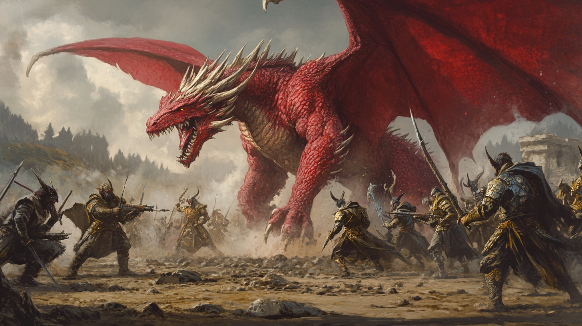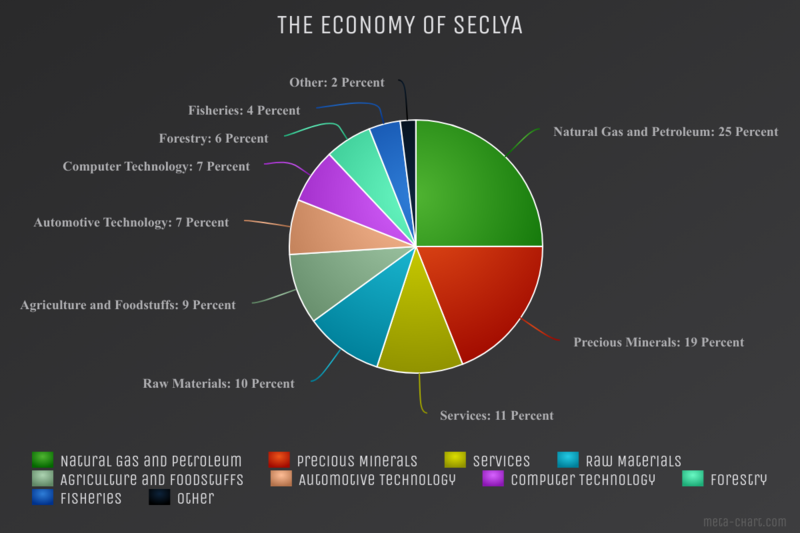Seclya
This article is incomplete because it is pending further input from participants, or it is a work-in-progress by one author. Please comment on this article's talk page to share your input, comments and questions. Note: To contribute to this article, you may need to seek help from the author(s) of this page. |
Saahein Sovereignty of Seclya Casariaat Saahein ria Seclya | |
|---|---|
| Motto: Dus Cresh Achait Vustarius Saahein Glory Eternal to the High Elves | |
| Anthem: Anareth Amorya | |
| Capital | Syva Aethel |
| Largest city | Haanathemar |
| Official languages | Saaheinic |
| Recognised national languages | Hakul |
| Ethnic groups |
|
| Demonym(s) | Seclyai |
| Government | Constitutional Monarchy |
• Ostrax | Ruven I Achax |
• Miax | Issarel Ermys |
| Legislature | The Vulmar |
| Sinaht | |
| Carralei | |
| History | |
• The First Saahein | Circa 25000 BCE |
• The Warring Tribes | 5000 BCE - 2500 BCE |
• Prisoners of the Hakul | 2500 BCE - 2000 CE |
• War of the Leaves | 2000 CE - 2005 CE |
• The Kingdom Age | 2005 CE - Present |
| Area | |
• Total | 5,551,400 km2 (2,143,400 sq mi) |
• Water (%) | 13.12% |
| Population | |
• 2024 census | 13,658,057,006 |
• Density | 118.54/km2 (307.0/sq mi) |
| GDP (PPP) | 2024 estimate |
• Total | $731.29 Trillion |
• Per capita | $53,542.76 |
| GDP (nominal) | 2024 estimate |
• Total | $725.84 Trillion |
• Per capita | $53,143.84 |
| Gini | 25.325 low |
| HDI | 0.912 very high |
| Currency | Cresh (Ꞇ) (CRS) |
| Date format | dd-mm-yy |
| Driving side | right |
| Internet TLD | .sec |
Seclya, officially the Saahein Sovereignty of Seclya (Saaheinic: Casariaat Saahein ria Seclya) is a Gothic Elven Kingdom ruled by the House of Rothilion-Ermys, situated across the south-central area of Gholgoth on the Tiamian Peninsula, south of Amador and Brewdomia. Ruling over a population of 13.6 billion citizens, the Sovereignty also lays claim to the Kritarchic Residuum in Varathron, though it has no functional control over said territory as of 2024. Headed by the duumvirate of Ostrax Ruven I Achax and his consort Issarel Rothilion-Ermys, the country juggles competing demands of its constituent races, the Saahein, Lashein, Lacerta and a small population of Stahd captives left over from its victory in the War of the Leaves against their former Hauklic masters. Most of its population resides in the south of the country, away from the harshness of the Marysia Mountains in the north. The capital city of Syva Aethel is also the country’s newest city, constructed by the elves after the conclusion of the war; its largest city is Haanathemar. It is one of the smallest nations in Gholgoth by population.
Seclya is a constitutional monarchy ruled by the Saahein, a race of elves who along with their Lashein cousins departed from Amador several millennia ago during the Amadorian expansion. The Saahein, like the native Lacerta population, were domineered into submission by the Hakulic and later Seclyai humans that would come to forge their own human empire in the land. Repressing their magical heritage, the Saahein would rise up with their Lashein and Lacerta allies during the War of the Leaves, overthrowing the yoke of their human captors and forming a high elvish kingdom in Seclya. The Royal Family of Seclya is formed by the marriage of an adopted son of Maeralya of Amador, Ruven Rothilion and the Amadorian Issarel Rothilion-Ermys. Part of the mission of the royal family is to pass down the newly released tradition of magic among the elves, along with creating a semi-autonomous partition for the Lacerta who sided with the elves during the war. Assisted by Amador, the country has rebounded from the war to become a highly-technological society of magic wielders.
The country has emerged from the war as a burgeoning center for the arts and sciences, with education becoming a central priority of the government. The highly centralized bureaucracy is dominated by its centerpiece organization, the Vulmar, its legislative body. Restoring the elves to their rightful highborn status, continuing the geological and ecological recovery from the war and contributing to a developing high-income economy are the chief concerns of the legislature and the government at large. The country sponsors numerous institutions of higher learning to help the elvish and lacertan population recover from the war and build a brighter future for themselves and their progeny. Despite its immense progress thanks to the Imperium Intervention during the war and its aftermath, Seclya in many ways remains a rebuilding nation trying to find its place among the Gothic north.
History
The lands of the Seclyai have been occupied by sentient species for the last 12,000 years. Earlier archaeological evidence does not support the existence of humanoid settlements in the region before that, though some evidence does support failed attempts by hunter-gatherers to set up colonies there. With the arrival of the Lacertans from Esvanovia around 10,000 BCE, the area now known as Seclya has been continuously inhabited. Seclyai history can be broken down into four main epochs: the Lacertan Hegemony, the dislocation of the Hein, the Hakulic invasion and subsequent dominion over Seclya, and the War of the Leaves and regency of the elves. The advent of Seclya as an elven kingdom is very recent in its history, though the name 'Seclya' has been around since nearly the beginning of humanoid occupation of the territory. Archaeological records identify Draxus Ballasar as the progenitor of the name Seclya, though the lands known to us as Seclya were originally called Beldorim.
The Lacertan Hegemony
The first humanoids to permanently settle the territory now known to us as Seclya were the Lacertans around 10,000 BCE. Having approached the Gothic lands from Esvanovia and modern-day Anagonia, the Lacertans were an evolutionary offshoot from the Drekamythians of Anagonian lore. Having chosen to follow a different path from their Drekamythian cousins in their following of Melkos Unchanos, the Lacertans under their demigod Draxus Ballasar self-exiled from Anagonia and traveled to the lands known as Seclya to settle and begin a new life for themselves. They named the land Beldorim, the Lacertan word for ‘’Land of New Beginnings’’, though Draxus would also bequeath the name Seclya to the land, the Lacertan word for ‘’’Land of Challenges’’’. It is not known whether the Drekamythians of Anagonia visited their Lacertan cousins in Gholgoth after the departure from Anagonia, though it is known that the Lacertans had contact with the Alfar fairly early on in their rule over Beldorim.
Rather than form a cohesive national identity, the Lacertan emigrants to Beldorim founded small, independent chiefdoms that served to govern the lands under their control. These chiefdoms often encapsulated villages of five to ten familial clans that would intermarry and breed with neighboring villages, thus fostering the next generation of offspring. Notable among the Gothic Lords of this era, the Lacertans did not engage in wars of territorial expansion, but were among the more peaceful races in the Gothic lands. Philosophers such as Kuphekurden Rhociar and Cirnekir Jardorim advocated for a peaceful coexistence with nature, working in harmony with the land to produce a workable living standard. Among the larger tribes of the era were the Arnaar, who encompassed more than a thousand square kilometers of territory among their Clan. The Arnaar were the first to build the ancient city-states of Beldorim among the mountainous peaks of the Rhociar Mountains. These cities would go on to form the backbone of the Saahein Sovereignty some 12,000 years later, reaching large population masses. Agriculture would first be cultivated among the Lacertans around 9,000 BCE.
As the ancient city-states grew, so too did the prevalence of amenities that would define the Lacertan population in Gholgoth. Tribes that formed these cities would often orient their towns and villages around game trails with superior hunting availability; still others near the coast preferred coves and craggy outcroppings, preferring the high places to the lowlands. The most famous ancient city-state, Ghevull would be built inside a cliff face, becoming a national heritage site in modern times. The prevalence of tribes marrying into other tribes continued, with the patriarch of the clan considered the head of the family. Inter-city commerce would pick up around 9000 BCE, with the first golden coins minted in Brenbarum and picking up in other city-states as well shortly thereafter. In 8700 BCE, the city-states of Ghevull, Brenbarum and twelve others formed the Lacertan Durjhan a hegemonic league of Lacertan city-states to counter the rising influence of humanity in Gholgoth. The Durjhan would remain in place for the next thousand years.
The Arrival of the Hein
Around 8000 BCE, the Saahein, the Lashein and the Lushein elves were banished from the Kingdom of Tiami. Kicked out of their ancestral lands for failing to yield to Tiami, the Hein elves would make their way south through Brewdomia to the lands of Seclya. At first, the elvish intrusion into the Lacertan lands led to violence between the native populations and the elvish interlopers. These feuds would be dissipated in short order by the Truce of Tel’var, an agreement that saw the ecologically minded Hein adopt lands not favored by the Lacerta for their own. The Truce, the first major formal treaty dividing parcels of land in Seclya, would prove to be the most successful such negotiation in the country’s history. After one thousand years of comingling, the Lacerta and the Hein had become staunch allies operating trade networks throughout their various city-states. The dark elves and snow elves, numbering far fewer than the high elves, would congregate with the Saahein in their cities and carve out enclaves for themselves. The elven emigrants would begin to develop sociocultural identities apart from one another as their time in Secyla increased.
The Saahein, owing to their prodigious upbringing and their highborn status, commanded vast field armies of high elven warriors and Lacertan mercenaries to defend the homeland, a condition that brought the two peoples closer together. The dark elves and the snow elves would find their niche in artisan roles, creating jewelry and ironworks for the more populous Saahein and the Lacertans. By 5000 BCE, the Lacertan and Saahein city-states began to negotiate mutual defense treaties, ensuring that the dominion of the Lacertans and the elves were both protected. Unification of the city-states never came to fruition however, despite the best efforts of city elders like Ramsas Tarkov and Eilyn Jorvas, who advocated for a Lacertan-Saahein Empire in the south of Gholgoth. The Lacertan and Saahein populations would remain independent of one another due to the differences in physiology and the Lacertan preference for living in the high places. The Saahein would instead look to impose order upon their dark elven and snow elven cousins, bringing all of elvenkind in Seclya under their governance. By 1000 BCE, the Saahein had consolidated all of what is now considered Seclya proper.
By 500 BCE, humans had been trading with the elves and the Lacerta for more than five centuries, bringing much prosperity into the lands of Seclya. Warning signs would begin appearing however in 471 BCE when a Gothic army under the barbarian-king Alainic would invade the southern city-states of the Saahein. A combined Lacertan-Saahein army would beat back the invasion, but multiple city-states had been sacked in the process. Lacertans withdrew to their high peaks and mountaintop fortresses, leaving the Saahein to their own devices in the lowlands. This pullback by the Lacertans would prove disastrous in the coming years. For the time being however, the ultimate defense of Seclya fell to the elves, who were still suppressing their magical heritage thanks to their banishment from the Kingdom of Tiami. Their inability to wield magic would leave them susceptible to another invasion, this time by a Gothic horde far more dangerous and brutal than that of Alainic's forces.
The Hakulic Invasion
In 382 BCE, a strange-tongued human people arrived in Seclya near the modern town of Tel’Vivec. Led by the warlord Braedel, the arriving Hakulic peoples would bring about the destruction of the elvish and Lacertan city-states and lead to centuries of unending misery for the population of both peoples. The War of the Haku would extend far beyond the northern shores of Seclya and encompass the entirety of the region, with the Hakulic raiders leaving neither elven nor Lacertan populations untouched. The Hakul would raid as far north as the easternmost reaches of Amador during their invasion of the Gothic territorie, doing tremendous damage before being repulsed back south by the forces of Amador. The failure of the Hakulic invasion north would spell disaster for the south as hordes of human barbarians wielding iron weapons would cut through entire swaths of elven defenders. The Lacertans would not come down from their high peaks, trusting in their fortresses to save themselves.
Braedel and his people began to enslave captive elves in their charge, creating death camps for their hostages as they approached individual cities. Years of independence led to a disassociated identity from the whole of the Saahein, leaving city-states at the mercy of the Hakulic invaders without much in the way of assistance from other city-states, many of whom were hoping to defend their own and profit from the destruction of competition in the economic marketplace. The Saahein badly misjudged the bloodlust of the Hakul however, and one-by-one the city-states of the Saahein would be picked off by the invaders. Braedel’s top general, Brighan would lead the armies of the Hakul into cities, razing them to the ground and affording little in the way of quarter to those captured. The elves that attempted to fight back would be savagely cut down by the superior number of the Hakul, again a symptom of the refusal of the Saahein and Lacertan settlements to unite under a common banner. The last Saahein settlements would be wiped out by the year 212 BCE, by which point the Hakul had fallen under the dominion of Braedel’s progeny. Haanathemar was the last elven city to fall in 202 BCE.
With the elven population subjugated in the lowlands, the Hakul turned their attention to the draconic Lacerta populations living along the coast and in the mountainous interior. At first, the Hakul struggled to make inroads into the majestic Marysia Mountains, lacking the proper siege technology that had been applied to the elven settlements in the lowlands. However, the arrival of Lashein, Lushein and Saahein soldiers under the banner of the Hakul would change the dynamic of the war and turn the Lacertan defenses on their side. Years of brainwashing in the concentration camps and forced breeding of elvish captives had created a generation for whom the Hakulic lordship over Seclya was the norm. They resented the Lacerta for their refusal to come to the aid of their ancestors and resorted to brute force tactics to overwhelm the city defenses of the Lacertan city-states. A brief coalition of Lacertans under Janos Miklas would emerge in 182 BCE to try and hold back the ever-expanding tide of the Hakul. Their efforts were in vain, however; with the elvish captives on their side, the Hakul set about dismantling the last Lacertan citiy-states. Dracamere was the last city-state to fall in 175 BCE. Its capitulation to the Hakul would bring about the Hakulic domination of Seclya, and centuries of human-led misery for the elves and the Lacertans.
Hakulic Domination
The Hakul would begin reshaping Seclyai culture to their whims, instituting a militant philosophy under the religion of Braedalism, which promised eternal life and victory to warriors living on the mortal plane. The spread of Braedalism also gave rise to the demonym Otherkin for the Lacertan, Lashein, Lushein and Saahein captives of the state. Elves in particular would suffer harshly under Hakulic domination over the next two thousand years, with their number entirely horded into breeding camps where the children would service the state and its needs at the expense of individual autonomy. The Lacertains would fare little better, suffering harsh retaliation for any streak of independence demonstrated in the population. Their overall numbers would greatly decline in the first century CE during the Plague of Oswelian, a pestilence that would kill Lacertans by the hundreds of thousands. The Hakulic humans, who by that point had renamed Seclya into Hakulia, did little to ease the suffering of the Lacertans, instead arresting them en masse and using them for nefarious medical and scientific experiments, many of which were needlessly barbaric and cruel to the Lacertans.
Hakulia would face periodic challenges to its dominion over Seclya, but little in the way of substantive resistance or reform were accomplished. Hakulia instead turned its eyes outward, expanding into Varathron and the Badlands Frontier, taking colonies for themselves and expelling the erstwhile population groups from their homes. The Hakulic intervention in Scailand in particular was a long and protracted, bloody affair that would see more than a century of open combat between 1525 and 1625 CE before it was finally brought to heel under the Hakulic banner. There was also an undeclared cold war between the elves of Amador and the Hakul in Seclya, both of whom viewed the other with deep suspicion. Vawrax Erwin II would go so far as to declare an embargo on all Amadorian goods in 1801 CE, though it was quietly lifted ten years later when it became clear that the Hakulic economy could not keep pace with the Amadorian economy. Hakulia instead took their pound of flesh from their colonial holdings, extracting resources and wealth from the natives under their dominion and leaving behind broken towns and destitute civilians. A cruel Gothic race, the Hakul would continue their dominance into the modern age.
The War of the Leaves
In August 2000 CE, a government agent and captive-born Saahein named Ruven Rothilion would be dispatched on a ‘mission of peace’ to the Amadorian Imperium. Making contact with his attaché Issarel Ermys, the two would spend some time together in the presence of Queen Maeralya and her court. It was during this sojourn that the dissident Ruven was taught by Maeralya of the history of the Saahein that had been suppressed by the Hakul. Sensing an opportunity to bring their enemies to heel, Maeralya would reignite the arcane nature of the Saahein in Ruven, and would send him back to Hakulia to sow discord amongst the restless Saahein captives under Hakulic control. Instead, Ruven would shock the whole of Gholgoth by reporting back to the Vawrax, Hans de Blathin that the Saahein would no longer stand for the treachery of the Hakul and, on live television, executed the Vawrax with magicks learned from his time spent in Amador. Escaping the government building with the assistance of several Lacertan guards, the newly-minted rebel leader would waste no time in going to ground organizing dissident cells of elves and Lacerta all over Hakulia.
At first, the War of the Leaves was a slow-moving one: the Hakul cracked down on any hint of separation from the camps in which the Hein had been raised. This only caused more dissention amongst the Saahein and their Lashein and Lushein cousins, many of whom deserted their positions in the camps and flocked to join Ruven and Issarel’s forces waging a war of independence against the Hakul. The war would go badly for the elves at the onset, as the superior firepower brought to bear by Hakulia caused immeasurable casualties. However, as time progressed, the Awakening of the Arcane in the Hein would begin to turn the tide, slowly but surely. As magicks began to find their usage on the battlefields, the non-arcane Hakul had no counter to the Saahein and their cousins. The Lacertans rose up en masse against the Hakul, joining Ruven’s confederation as allies. Learning the lessons that their ancestors had failed to heed centuries before, the Hein and the Lacerta began to move as one, and the War began to turn. One by one, Hakulic cities would be picked off as the military leadership of Ruven and Issarel began to assert itself. The dominion of the Hakul over the Hein and Lacerta was broken.
By 2003, the War of the Leaves had turned against the Hakul, so much so that they began to implement a strategy of mass terror by using nuclear weapons to bomb Elvish positions, irradiating their own country in an effort to stem the flow of resources coming in from Amador to the Hein. The nuclear bombing of Rashariatt would kill more than a million elves and some 600,000 humans still defending the town from the Lacertan and elvish challenge. This would prompt the Alfar of Amador to finally enter the war on the side of their Hein cousins, bringing the full might of the Imperium down on the Hakul. The war began to look very different as the Amadorians took control of key economic and political corridors in the country, using its massive advantage in personnel and magicks to wipe away the Hakulic defenders. The Hakul retaliated by using more nuclear weapons on their own soil, decimating the Saahein and the Lacerta but also killing more humans in the process. The Amadorians would take the initiative in the north while the remnants of Ruven and Issarel’s battered army moved south past the Marysia Mountains, looking to cut the head off of the Hakulic snake once and for all in a decisive 2004 military campaign.
The endgame of the War of the Leaves, also known as the Blood War by the Hakul and some Seclyai observers, began in January with the capture and destruction of the Hakulic capital of Mecklensturtz. The control of the military of Hakulia by this point had fallen to Armin Kuhne, the Anführer, who was leading a Group of Seven in the prosecution of the war. Amadorian forces pushed further inland from the coast after destroying Mecklensturtz, approaching the foothills of the Marysia Mountains by May. The Saahein had a more difficult path to victory against the forces of Klaus Stahl and Ansgar Wolffe. Slowly however, the Saahein and their Lacertan allies began to push north towards the Marysia Mountains themselves, trapping the Hakul in the Marysia Pocket. Seven attempted breakouts would fail before the eighth and final attempt succeeded in driving a wedge in the Saahein lines. The Hakulic forces would retreat to the Kritarchic Residuum of Hakulic Varathron and Scailand, abandoning entire divisions along the way. The Saahein, attempting to pursue them, were no longer in a shape to prosecute a war, and they linked up with the Amadorians in the Marysia Mountains on July 19, 2004, the symbolic end to the war.
The Saahein Sovereignty
Geography
Climate
Biodiversity
Government
National
Subdivisions
Foreign Relations
Saahein-Amadorian Relations
Seclya maintains important relations with Amador through a series of formal documents and through the marriage of Ruven Rothilion-Ermys and Issarel Ermys. Both nations posses a mutual defense pact, sworn to defend one another should one be attacked. Formal relations were established following the end of the War of the Leaves, which saw Amador intervene and ultimately help the Saahein and Lashein elves overthrow the previous human-dominated Selcyai government.
Seclya and Amador are intertwined economically and culturally and have close diplomatic relations following the end of the War of the Leaves. Both militaries regularly carry out joint trainings and the navies of both nations form a a collective barrier against Scandinvan aggression. As a show of trust, almost complete unrestricted travel is permitted between the two countries.
Amador has made an enormous economic impact in Seclya following the rise of the Saahein Sovereignty in an effort to rebuild the war-torn country and to revitalize the shattered economy. Both nations have established an annual grant to the Sovereignty in exchange for the establishment of the Saahein-Alfar Free-Trade Agreement (SAFTA), a free-trade agreement which eliminates tariffs and taxed among imported and exported goods between the two nations.
Military
Law Enforcement
Demographics
Population
Religion
Largest Cities
Health
Education
Primary
Secondary
Tertiary
Arcane Universities
Culture
Symbols
Sports
Literature
Arts
Media
Influences
Amadorian Influence
Economy
Main article: Economy of the Saahein Sovereignty of Seclya
The economy of the Saahein Sovereignty is one of the most developed in Gholgoth, thanks in no small measure to the pre-war focus on economic strength by the Hakulic-Seclyai and their free market orthodoxy, which has been adapted by the new confederation of Sovereignty races into a highly articulated artisan economy. Assistance from the Kingdom of Amador in the form of trade agreements have also helped the new elvish economy recover greatly from the War of the Leaves. The country boasts a high standard of living with redistributive wealth policies to care for the poorest of the land. The Gross Domestic Product (GDP) is estimated at around $725.84 Trillion NSD, with a GDP Per Capita (Nominal) of $53,143.84 NSD. Seclya maintains an average compounded economic growth rate of 3.7% annually, and has seen its unemployment rate drop below 4% for the first time in 2024 since before the war. The highly specialized economy is one of the largest in Gholgoth.
Seclya possesses a mixed market economy with Elven characteristics, with a highly skilled labor force, relatively low levels of corruption, and a high level of technological innovation thanks to its ancient roots and the assistance in development by the Kingdom of Amador. The country’s central government operates as a dirigiste force on the economy as a whole, exerting regulatory oversight and redistributive policies to help spread capital throughout the economy and the population in general. The country’s citizens receive a universal basic income (UBI) to help meet basic needs, while certain inalienable rights like universal child and healthcare, free higher education and housing and nutritional assistance are held sacrosanct. The country is a net exporter of goods, though the trade surplus has begun shrinking in recent years as the explosive population growth has led to higher consumption and a greater market demand for goods. Seclya’s top exports include agriculture, artisan goods, forestry products, furniture, precious minerals, raw materials and an abundance of mineral resources like copper, lithium, and tin.
The Seclyai have one of the highest average household incomes in Gholgoth, with a high median household income thanks to efforts to reduce the wealth gap through redistributive economic policies. Income inequality has dropped by 2% year-on-end since the War of the Leaves, though a sizable wealth gap still remains thanks to the pre-war legacy of the market economy. The poverty rate hovers around 4% thanks to government interventions in healthcare, housing, education and food assistance. Food security is a highly prized government intervention thanks to the country’s agricultural output, strong agricultural subsidies and the social safety net. The large welfare state, backed by the strong Seclyai economy, guarantees paid vacation time, maternity and paternity leave, and compulsory health coverage through the state-owned healthcare system. Artisan guilds and trade unions have collective bargaining rights with their employers for better compensation packages.
Structure
The Seclyai economy is structured around resource extraction and exports, maintaining a trade surplus of roughly $245 Billion NSD. Much of the country’s infrastructure from the prewar years was designed to bring material wealth out of the country’s interior to its major ports. Efforts in recent years to establish a more egalitarian economic infrastructure has led to increased efforts to keep wealth localized to municipalities, but resource exports remain the bread and butter of the Seclyai economy. Liquified natural gas and refined petroleum are the two largest economic powers in the Seclyai economy, accounting for almost a quarter of the nation’s economic output. Companies such as Valvaris, Glynmenor and Ilixalim are some of the largest energy corporations in Gholgoth by trade value. There has been a push in recent years to divest from the energy sector as it currently exists due to concerns about climate change; the endowment group Hagre Fenlen is one of the largest green technologies lobbies in Seclya, and have spearheaded the movement by the government to reduce its own carbon footprint. Nevertheless, energy exports remains the largest economic sector and will continue to be the dominant resource export for some time to come, with the country expected to produce more than 20,500,250 barrels of oil per day by January 2025.
Precious minerals and raw materials account for nearly thirty percent of the economic output of the Seclyai economy. Gold and silver ore account for sixty percent of the precious minerals market in Seclya, with diamond and ruby production accounting for another thirty percent. It is estimated that Seclya sits atop one of the largest diamond reserves in central Gholgoth, though production has decreased year-on-end thanks to renewed climate protections placed on the mining industry. Precious metals such as platinum and palladium are found in abundance in the central interior of the country and have become an extremely lucrative trade in the twenty-first century. Metals such as aluminum, copper, tin and zinc are mined extensively, and the production of iron ore has increased by more than half since the turn of the century. Raw materials represent the fastest growing economic sector in the country, with its market share increasing by ten percent over the past fifty years. Copper production in particular has seen a large jump in overall market share. Though downsized in importance with new climate initiatives by the government, coal production remains a valuable resource for Seclya.
The Seclyai economy relies on the Cresh (Ꞇ) as its currency, backed by the country’s strong economy and military strength in the central Gothic lands. The Amadorian Aeures (₳) is utilized as a de facto currency following the War of the Leaves between 2000 and 2005. The country’s principal economic center is the city of Haanathemar, where the Naeris Stock Exchange and the CRAELEE Index are located, two of the largest in Gholgoth by trade volume and market capitalization. Haanathemar is considered one of the country’s major economic and cultural centers, featuring the largest municipal GDP in the country. Seclya is considered a regional leader in resource production, and has a growing technological community advocating research, sciences and technology. The country's economy is fueled by abundant natural resources, a well-developed infrastructure, and high productivity. The Amadorian Imperium is the largest trading partner of the Saahein Sovereignty.
Tourism
The tourism industry has greatly expanded in the years following the War of the Leaves, with the country opening its doors to foreign tourists for the first time and advocating for increased visitation to the country’s ubiquitous mountain resorts and baths. Seclya’s interior mountains are rich with geologic activity, creating natural hot springs that draw in hundreds of thousands of visitors from abroad each year. Major metropolitan areas such as Morn Iyhelume and Isyh Alora have also increased their advertising budget drawing in both domestic and foreign-born tourists by the hundreds of thousands. War tours showcasing the history and heritage of the War of the Leaves is a prominent historical tourist industry in the country. Gambling is a burgeoning industry in Seclya, with the act legalized throughout the country, leading to the rise of casino resort hotels in the major metropolitan areas: Mathathas is considered the gambling and resort hotel capital of Seclya, with more than thirty casino resorts to its name. Also of interest are the nation's indigenous Lacerta communities, where traditional art and literature, theater and sports are showcased to rapt audiences. The country's ever-expanding educational system brings in millions of foreign-born students each year, giving rise to college towns that draw in millions of family members each year. Summer tourism dollars are an important part of the local coastal economies as the nation's citizens flock to the beaches during the warm months. Air travel to Seclya has become cheaper in the post war years thanks to increased air infrastructure.
Infrastructure
Seclya possesses a unique infrastructure owing to its Hakulic past, with much of the country united by the military aims of the former Seclya Formation and thus possessing a robust infrastructure network designed to move large amounts of people and freight about in a secure and timely manner. The country is perhaps most known for its famous underground highways, large bored tunnels through bedrock that were originally purposed for military usage and have since become the nation’s main civilian highway infrastructure. Following its victory in the War of the Leaves, the Saahein Sovereignty adopted the Ifa Serine Protocol in developing a robust public transportation network in and around the nation’s cities. The engineering projects created through the use of elven labor and magicks are some of the largest in Gholgoth during the twenty-first century. Much help was derived from the Amadorian Imperium following the war in helping to rebuild a war torn society.
The nation’s geography has favored the development of water-based transportation through the usage of its navigable rivers and canals. As a major exporter of energy, minerals and raw materials, the country’s infrastructure is designed to extract resources from the interior and move them to the country’s major port facilities. Civilian traffic on the waterways has increased in recent years thanks to the country’s push to revitalize its green industry sector, lessening the emissions from the country’s overland road system. Air travel has become popular in the postwar years thanks to the Amadorian example of airship travel. Construction has commenced in most major cities for ‘sky ports’ for airships of varying sizes to accommodate long-distance travel between cities.
Energy
Seclya’s energy grid is a mixture of various formats, with the country having invested heavily in green energy sources and renewables in the postwar years. As of 2024, more than seventy percent of the country’s energy production comes from nuclear power stations, making it one of the most robust nuclear energy grids in Gholgoth. The country increased its nuclear production to its current levels through investment in hypermodern reactor designs, boasting plants that can utilize nuclear waste in its reactors. Cold fusion technology has become a major priority for the country owing to the Ushya Accords which sets a target for nuclear fusion energy by the year 2045. Two research laboratories in Hela Thalas and Isyh Alora have produced small fusion reactions in their reactors, leading to the hope that the country will meet its fusion project deadline ahead of time.
Twenty percent of the nation’s energy comes from geothermal energy thanks to its highly active geological resources, with the remaining ten percent coming from hydrothermal, natural gas, solar and wind energy. The country’s last oil and coal fired energy plants went offline in 2021 and 2023, respectively. The country is blessed with an abundance of oil and natural gas deposits, making it one of the region’s largest liquified natural gas and petroleum exporters. The country has set a target of 2050 to reach net zero emissions and to reduce GHC emissions by eighty percent by the year 2040. Owing to Amadorian support, Seclya has emerged from the postwar period as one of the greenest nations in Gholgoth.
Transportation
The Saahein Sovereignty has spent much in the way of fiscal and materiel resources in rebuilding the country’s transportation grid following its victory over the Hakulic peoples in the War of the Leaves. With support from its Amadorian allies, the country has embarked on a massive public transportation spending spree along with conversion of its former wartime assets into civilian use infrastructure. Public transportation infrastructure accounted for nearly ten percent of discretionary spending by the government in 2024, owing to efforts to expand its airship infrastructure. Much of the public transportation networks have gone green, with electric vehicles and light rail networks contributing to the push for cleaner transportation technology. The country’s public transportation grid in totality boasts a seventy percent eco-friendly proportion, with the stated aim of raising that to full capacity by the year 2040. Municipal grid development has become a major government initiative in recent years.
Road Network
Despite its investment in public transportation infrastructure, Seclya is still dominated by the automobile. An extensive network of highways and roads crisscross the major Seclyai cities, with urban road networks stretching for miles across the landscape. The Royal Highway Authority (Vulred Omalynn Terissys) monitors and observes road-based transportation in the country, creating standardized rules for infrastructure including bridges and viaducts, pavement composition and lane width. Uniquely however, the country’s infrastructure network does not include expressways between the major cities in the traditional sense. The former highway system of the previous government has been repurposed for usage as bike trails, greenspaces and solar and wind farms. The transformation of the overland road network was part of the nation’s greenbelt initiative designed to encourage public transportation and limit the presence of gas-consuming cars on the road in favor of electric vehicles. Today electric vehicles make up forty percent of the automobiles on the road, with that number expected to rise by twenty percent in 2030 as the nation utilizes its lithium deposits. Seclya seeks to eliminate gas-powered engines from its roadways entirely by 2060.
In place of a traditional highway network, the Seclyai government has uniquely turned military infrastructure into civilian infrastructure with the creation of the Andrathath Larrel highway system. Prior to the War of the Leaves, the Hakulic government had built large underground tunnels traveling for hundreds of miles, connecting major cities with one another for use as a military transportation grid safe from aerial bombardment or assault. The Saahein government repurposed these long military tunnels into commercial thoroughfares, with the requisite infrastructure all based underground. Carbon capture technology limits the amount of carbon dioxide and other emissions from reaching the surface, thus helping to combat climate change by lessening the nation’s carbon footprint. This expensive infrastructure is buoyed by a special tax levied in the form of a toll charge to enter the network of underground road connectors. Thanks to the herculean efforts of the government, and with support from its allies, the underground connectors function like a robust expressway system for the country. It is one of the most technologically advanced roadway networks in all of Gholgoth, costing more than $300 billion annually to maintain.
Rail
The utilization of railway infrastructure is not new in Seclya; the country had developed a robust network of rail lines for moving cargo freight and military personnel during the Hakulic administration. In the years since the War of the Leaves however, the Saahein government of Seclya has made it a mission to improve railway access for individuals in commercial and civilian usage. Maglev technology has made high speed rail infrastructure a reality between the major cities, helping boost public transportation through railway transportation of people and goods. Old railway lines have been revitalized and used for long and short distance cargo freight hauling. More than 200,000 miles worth of commuter rail lines exist in Seclya, making it one of the largest railway networks in Gholgoth. Commercial and civilian rail transit is publicly owned in Seclya.
Of particular interest is the prevalence of rail transit as a means of public transportation in the major metropolitan cities. Every town over five thousand people are guaranteed public transportation funding from the central government in Syva Aethel, while those under that threshold can self-fund a public grid at their own discretion. While most every city has state-owned buses, shuttles and trolleys operating on their roads, many cities of size have turned to rail transit for their public infrastructure needs. Light rail is one of the most popular forms of public transit in the country, with more than three dozen cities employing the technology as of 2024. Monorail and subway transit are also popular options in Seclyai cities.
Airfare
The abundance of public transportation options and the country’s unique road infrastructure made air travel internally less of a factor prior to the War of the Leaves. With travel restricted to military personnel and civilians lacking the legal agency to travel about, air travel was never a priority for the Hakulic government. Under the Saahein administration of Ruven and Issarel, however, air transportation has become a major investment opportunity for the government. The country has invested in development projects for hundreds of airport terminals across the country, and have publicly invested in new aviation developers like Ilyana Air to help the country’s young airline industry take flight. More than a dozen carriers now operate at over fifteen thousand airports around Seclya, an increase from twelve thousand airports in the year 2010.
The government has attempted to capitalize on the increase in civilian air traffic in Seclya by bolstering its own public transportation grid through air power. Air taxis in the form of state-owned helicopters ferry passengers to and from major cities while domestic carriers receive public funding to help expand their operations. Of particular interest is an imported custom from the Amadorian Imperium in the form of airships, zeppelins capable of ferrying a throng of people from one city to the next. These airships are considered public transportation owned by the state, and have led to the development of considerable infrastructure in the form of docking ports on skyscrapers in the country's major metropolitan areas.
By utilizing existing buildings as 'sky ports' for the zeppelins, airship transportation has become a viable means of long-distance public transportation for those unable or unwilling to purchase airfare on the nation's airlines. Between the nation's domestic and international airline carriers and the airship transportaiton service offered by the Saahein government, more than one hundred million people annually utilize air transport in Seclya, a five hundred percent increase from the immediate post-war figures in 2005.
Seaports
As an industrialized, resource-based economy, Seclya’s port system is both robust and well-developed. Having inherited a system put in place by the prior Hakulic administration, the Saahein Sovereignty continued investing in port infrastructure well into the reign of Ruven and Issarel. More than five hundred port facilities, including the rise of Ianphine Superports have been invested in over the twenty-year reign of the Seclyai duumvirate, with more than a dozen new port facilities at created deep water harbors under construction as of 2024. Green energy technologies like surf and hydroelectric power are fueling new ports, helping to reduce their carbon emission footprints. Moreover, air and rail infrastructure is helping to bring more cargo freight to Seclyai coastal installations around the country. The government spends more than $100 Billion annually on port expansion and upkeep. With port facilities overextended in some areas, the government has begun to build artificial ports in harbors and at sea, using smaller boats to ferry cargo from container ships into the main port facility. These Keyyra Ports have exploded in growth, and been paired up with artifical landing strips at sea and concrete islands used by the Seclyai military for the purposes of defense of commercial traffic and offshore port facilities. Another $50 Billion is spent annually attempting to prevent cargo theft and tampering at sea in a boost to the country's port infrastructure. The country's seaports represent a monumental asset to the Seclyai economy and its resource-driven export marketplace.
Water Network
Like their Amadorian cousins, the Seclyai possess a bounty of navigable waterways that aid in the ship-based transport of people and cargo to and from cities along the many rivers in Seclya. The country’s investment in river-based transport ranges from ferries that convey cars and foot traffic across waterways in the country to river barges that transport people greater distances between cities. These “river taxis” are some of the newest civilian transportation infrastructure in the Saahein Sovereignty thanks to Vulmar legislation in 2019 authorizing the creation of a fleet of barges and ferries for transportation purposes. Most of the traffic on Seclyai riverways is commercial in nature however; cargo ships pass through waterways such as the Aiduin, the Halflar and the Tiarsus Rivers, transporting freight to the country's many port facilities.
River-based commercial and freight traffic has come under intense scrutiny over the past two decades as climate activists and environmentalists have protested the ecological damage done to the nation’s rivers. In fact, much of Seclya’s domestic waterways were heavily polluted by industrial runoff in the pre-war years, as the Hakulic government placed little emphasis on ecological affairs or environmental protections. Much has been done to help repair waterways to their natural health over the postwar period, including limiting the dumping of chemical byproducts into waterways and spending countless amounts of money and resources to clean the rivers themselves.
















